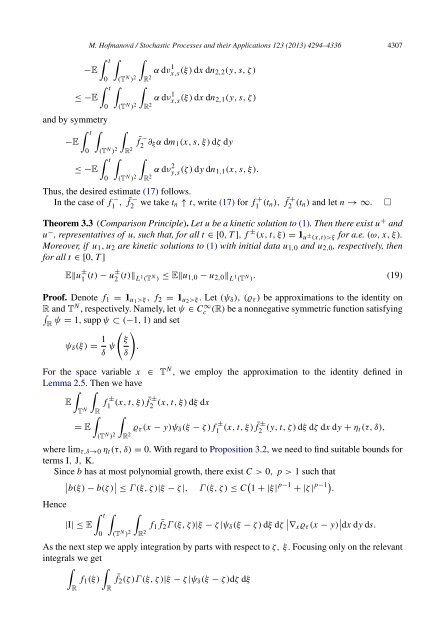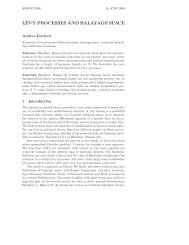Degenerate parabolic stochastic partial differential equations
Degenerate parabolic stochastic partial differential equations
Degenerate parabolic stochastic partial differential equations
You also want an ePaper? Increase the reach of your titles
YUMPU automatically turns print PDFs into web optimized ePapers that Google loves.
M. Hofmanová / Stochastic Processes and their Applications 123 (2013) 4294–4336 4307<br />
t <br />
−E<br />
α dν<br />
0<br />
(T 1 N ) 2 R 2 x,s (ξ) dx dn 2,2(y, s, ζ )<br />
t <br />
≤ −E<br />
α dν<br />
0<br />
(T 1 N ) 2 R 2 x,s (ξ) dx dn 2,1(y, s, ζ )<br />
and by symmetry<br />
−E<br />
t (T N ) 2<br />
0<br />
≤ −E<br />
R<br />
2<br />
t (T N ) 2<br />
0<br />
¯ f − 2 ∂ ξ α dm 1 (x, s, ξ) dζ dy<br />
R 2 α dν 2 y,s (ζ ) dy dn 1,1(x, s, ξ).<br />
Thus, the desired estimate (17) follows.<br />
In the case of f − 1 , ¯ we take t n ↑ t, write (17) for f + 1 (t n), f ¯ + 2 (t n) and let n → ∞.<br />
f − 2<br />
Theorem 3.3 (Comparison Principle). Let u be a kinetic solution to (1). Then there exist u + and<br />
u − , representatives of u, such that, for all t ∈ [0, T ], f ± (x, t, ξ) = 1 u ± (x,t)>ξ for a.e. (ω, x, ξ).<br />
Moreover, if u 1 , u 2 are kinetic solutions to (1) with initial data u 1,0 and u 2,0 , respectively, then<br />
for all t ∈ [0, T ]<br />
E∥u ± 1 (t) − u± 2 (t)∥ L 1 (T N ) ≤ E∥u 1,0 − u 2,0 ∥ L 1 (T N ) . (19)<br />
Proof. Denote f 1 = 1 u1 >ξ , f 2 = 1 u2 >ξ . Let (ψ δ ), (ϱ τ ) be approximations to the identity on<br />
R<br />
and T N , respectively. Namely, let ψ ∈ Cc ∞ (R) be a nonnegative symmetric function satisfying<br />
R<br />
ψ = 1, supp ψ ⊂ (−1, 1) and set<br />
<br />
ψ δ (ξ) = 1 δ ψ ξ<br />
.<br />
δ<br />
For the space variable x ∈ T N , we employ the approximation to the identity defined in<br />
Lemma 2.5. Then we have<br />
E<br />
T N <br />
= E<br />
f ± 1 (x, t, ξ) ¯<br />
R<br />
(T N ) 2<br />
f ± 2<br />
(x, t, ξ) dξ dx<br />
R 2 ϱ τ (x − y)ψ δ (ξ − ζ ) f ± 1 (x, t, ξ) ¯ f ± 2 (y, t, ζ ) dξ dζ dx dy + η t(τ, δ),<br />
where lim τ,δ→0 η t (τ, δ) = 0. With regard to Proposition 3.2, we need to find suitable bounds for<br />
terms I, J, K.<br />
Since b has at most polynomial growth, there exist C > 0, p > 1 such that<br />
b(ξ) − b(ζ )<br />
≤ Γ (ξ, ζ )|ξ − ζ |, Γ (ξ, ζ ) ≤ C<br />
<br />
1 + |ξ| p−1 + |ζ | p−1 .<br />
Hence<br />
|I| ≤ E<br />
t (T N ) 2<br />
0<br />
R 2<br />
f 1 ¯ f 2 Γ (ξ, ζ )|ξ − ζ |ψ δ (ξ − ζ ) dξ dζ ∇ x ϱ τ (x − y) dx dy ds.<br />
As the next step we apply integration by parts with respect to ζ, ξ. Focusing only on the relevant<br />
integrals we get<br />
<br />
f 1 (ξ) f¯<br />
2 (ζ )Γ (ξ, ζ )|ξ − ζ |ψ δ (ξ − ζ )dζ dξ<br />
R<br />
R<br />
□



